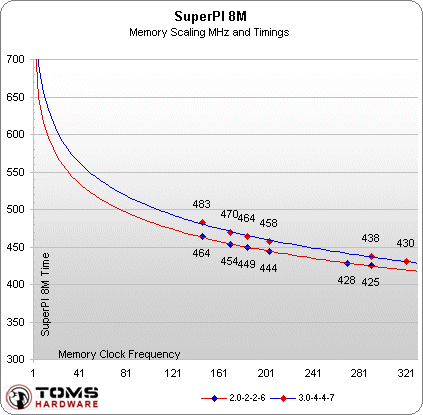Tight Timings vs High Clock Frequencies
Low Timings Or High Clock Frequencies?, Continued
Based on a few assumptions, 270 MHz @ CL2.0-2-2-6 outperforms 320 MHz @ CL3.0-4-4-7 by two seconds in SuperPI 8M. Read more below.
This is what the scaling performance in SuperPI could possibly look like - it is purely hypothetical, of course. The graph above requires an explanation, and please don't be too picky, since it's not very scientific. Also, performance will probably be much worse at lower clock frequencies than this graph shows.
We used Excel to generate a logarithmic trend curve based on five real measurements with both relaxed and tight timings. We tested at 145, 169, 184, and 203 MHz - the highest we could reach with both timing sets. Using relaxed timings, we also got a measurement at 290 MHz.
We then added a theoretical tight timing measurement at 290 MHz, calculated from the 4.6% better performance at 290 MHz compared to 203 MHz at high timings that we measured at a 2030 MHz CPU speed. The theoretical 290 MHz measurement with tight timings could be both lower and higher, depending on how much of a bottleneck the CPU clock frequency turned out to be, as also noted earlier.
Based solely on the first scaling results, it is more likely that the advantage of using tight timings will be less than 4.6% at this low CPU clock frequency.
Basing the equation only on the real measurement points, at 290 MHz the difference would only be 2.1%, and 320 MHz at CL3.0-4-4-7 would outperform 270 MHz at CL2.0-2-2-6 by 3 seconds. We think that the measured results are too far away from these high speeds to say that for certain with just four data samples, though.
At higher CPU clock frequencies, the importance of memory speed is larger both in SuperPI and in 3DMark01. In SuperPI, the gain from tight timings (at 203 MHz memory clock) was 3.2% at 2030 MHz CPU clock, and 5.1% at 2610 MHz. In 3DMark01 the gains were 2.3% and 5.7%.
Get Tom's Hardware's best news and in-depth reviews, straight to your inbox.
The gains when going from 203 to 290 MHz were 4.6% at 2030 MHz and 5.2% at 2610 MHz in SuperPI. For 3DMark01 the gains were 3.5% and 5.7%. See the graph below for a better overview.
If we were to draw any conclusions from this graph, it would be that SuperPI prefers tight timings, while 3DMark01 prefers high clock frequencies.
Current page: Low Timings Or High Clock Frequencies?, Continued
Prev Page Tight Timings Or High Clock Frequencies? Next Page Benchmark Conclusions-
jona1 Excellent article. I was looking for a good explanation of memory timings. Thank you (I am from Uruguay, sorry for my bad English :) )Reply -
Good Article I guess. I've been wondering that exact question now that i got 2x1GB of Patriots PC2-8500 Viper Series from NVISION08. The timings are 5-5-5-15 2T at 1066MHz. When i try to lower it 1T it's not reliable. Anyways, thanks tomshardware for another good article, I hope there is a sequel to this, specifically DDR2 or 3 memory.Reply
-
spellbinder2050 ReplyAs most of you are probably aware, the MHz clock speed of the Athlon 64 and Opteron is the product of the HyperTransport speed (HTT) times the multiplier of the CPU.
Correct me if I'm wrong, but shouldn't this be written as, "the MHz clock speed of the Athlon 64 and Opteron is the product of the HyperTransport speed (HTT) and the multiplier of the CPU."


